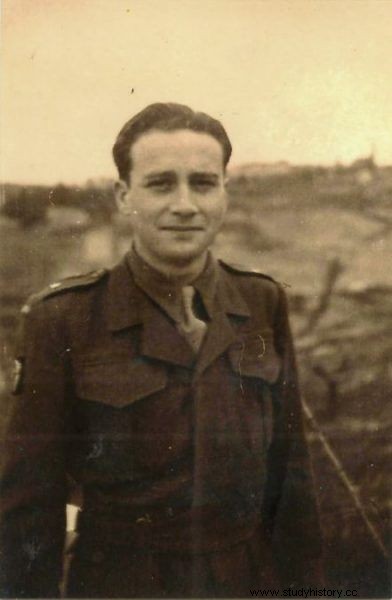Cut off from the world, crowded and hungry. At the mercy and disgrace of the Germans. People locked up in the largest ghetto in Nazi-occupied Europe did everything to get at least a substitute for normalcy. How was their daily life like?
The Warsaw ghetto was closed on November 16, 1940. At its peak, in the summer of 1941, 460,000 Jews lived there. A few months later, Stanisław Aronson, pseudonym. "Rysiek", who later became a member of the elite "Kolegium A" of Kedyw and fought in the Warsaw Uprising. His parents preferred to live in the ghetto than to end up in one of the camps. As he mentions in the book "War Comes Tomorrow":
I was sixteen. Then I saw the first dead body on the sidewalk. He was like a wax doll, pale as my sister's toy; he was lying covered with a newspaper. And the same zombies in the streets, crowds of zombies in rags . It was a shock. Then my life ended, my youth ended.
Man gets used to it
The first days behind the walls were difficult for a teenager. He was struck primarily by the omnipresent hunger (from the moment the ghetto was established to the commencement of the deportation of its people to Treblinka on July 22, 1942, about 90,000 people died of disease and malnutrition). However - as he notices - after some time a person gets used to these shocking views:“A day, two, or a few days passes and the walking dead on the streets do not make any impression. Or that someone is lying on the sidewalk and is dying. Or he is already dead, he is under the newspaper. ”

Stanisław Aronson (pictured in 1946) lived in the ghetto for less than a year. He managed to escape from the transport to a concentration camp and joined the resistance movement.
He himself was very lucky. His family, despite the tragedy of the situation, was doing quite well - mainly financially. In the book "War will come tomorrow", written in the form of a river interview with journalists Emil Marat and Michał Wójcik, Aronson confesses:"I have never worn rags, I have never been forced to steal a slice of bread. I've never been a smuggler. " But he adds:
We were a bit richer. Everyone in the waiting room until death, although we didn't know it yet. And some in that waiting room were starving, some weren't . Some wore rags, others did not. Does it matter?
According to his estimates, about twenty percent of the ghetto inhabitants lived in the worst conditions. The situation for the rest of us continued to worsen, but it was not fatal. "Badly dressed, hungry, they bought on the black market, but somehow lived," he relates. He himself remembers the period of less than a year, which he spent with his family outside the walls, surprisingly… monotonously. During the day he went to work (it was the duty of Jews in the ghetto), and in the evenings he studied in secret classes. As he says:
I worked in an Astra calculating machine factory. The job was even good. From eight in the morning to six in the afternoon. They were giving us a meal there. In the evening I returned home. On the way, I was able to observe the city. I saw what was happening. But, fortunately, I have never seen a gendarme kill someone.
The ghetto was dying by itself
Before, in July 1942, the Germans decided to deport Jews from the Warsaw ghetto to the gas chambers in the Treblinka extermination camp, the streets of the closed district were crowded and noisy. Despite the ghost of garbage hanging in the air, life flourished there - street trade, industry, services, but also culture and entertainment in the form of concerts, theater performances and religious events.

The text is based on the book by S. Aronson, E. Marat and M. Wójcik, War will come tomorrow (Znak Litera Nova, 2019).
The provisioning situation was terrible. There was a shortage of food, medicines, basic hygiene measures. But apart from that - strange as it seems - there was peace outside the walls. As Stanisław Aronson recalls in the book "War will come tomorrow":I remember this absurd calm. (...) Hunting for people, round-ups, I saw it only on the other side of the wall. After that. Such a paradox. The Germans did not go around the ghetto as eagerly as they did in Warsaw . They did not terrorize the people in the streets.
Maybe some Hitler Youth trips, maybe some soldiers on vacation. They came by like on a safari, shoot, laugh, but it wasn't much. The ghetto was dying by itself until the deportations. From hunger.
All of that changed on July 22nd. The streets became dead and empty overnight. Only columns of people chased to the Umschlagplatz moved in silence. The Aronson family was also among them. Stanisław and his parents were then separated. They never met again.
He himself managed to get out of the transport while the train stopped in a field near Warsaw. He broke through to the window in the cattle car and jumped outside. It was January 18, 19 or 20, 1943. About the escape, he says:“I was eighteen, I was strong, I managed it. (...) Nobody noticed me, nobody was shooting. I wanted to live. (…) I felt that I could not shut up. Those were the times when such impulses decided about life. Life depended on chance ”.
Bibliography:
The text is based on a book by Stanisław Aronson, Emil Marat and Michał Wójcik “War will come tomorrow. A soldier of the legendary Home Army Kedyw warns ” (Sign Letter Nova, 2019).

